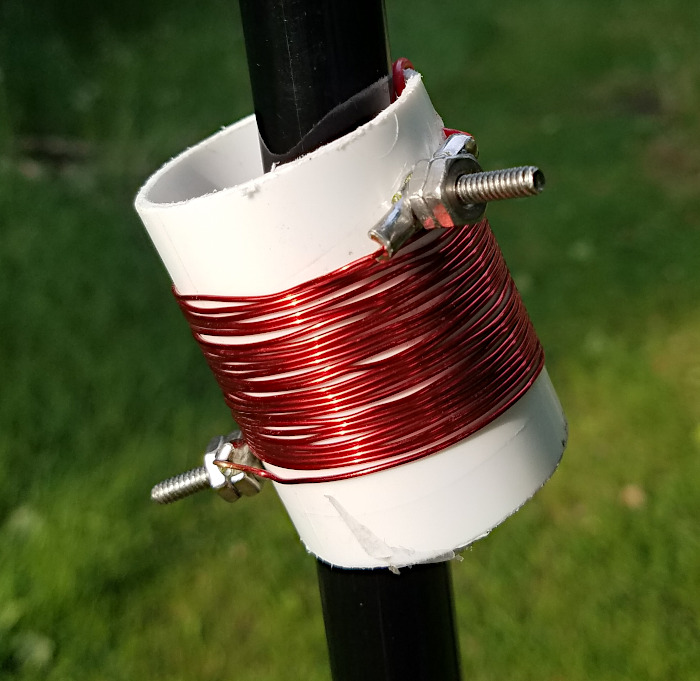Here is a photo of the loading coil made from the overflow tube:

To make the loading coil, I drilled two holes for 6-32 stainless screws 3/4 of an inch long. I used crimp connectors to attach the enamel wire with the screws. When using enamel wire, make sure you scrape off the insulation from the wire. Then use ring type crimp connectors to attach to the screw. In this type of application, I like to solder the crimp connectors to the wire. This insures a good connection and is more resistant to corrosion when used outdoors. Additionally, I use two nuts on the screw which prevents them from loosening during use. As you can see, my winding skills aren’t the greatest, but that’s OK, its still functional.
May i know if the radials requires elevation above the ground or just leave it laying on the ground?
Hello,
I always lay them on the ground simply because it is easier. If the radials are elevated, it will perform better. Even though elevating the radials gives better performance, I have not been disappointed with this antenna’s performance with the radials on the ground.
Hope this helps.
— Mike WB8ERJ
Mike
Thanks for the inspiration – I have parts on the way to build one – I’m an antenna neophyte – I noticed you don’t have any kind of transformer or inductor on the antenna input – is this simply a function of the loaded vertical design? (Whereas with an EFHW one is needed)
Thanks!
Michael
KD7PTZ
Hello Michael,
Thanks for checking out my blog. You are correct. There is no need for a transformer on a vertical since its impedance at resonance is close to 50 ohms. Actually between 35 and 70 ohms depending on the radial orientation, but not to worry about that. There are too many other uncontrollable factors in the real world of antennas to be concerned with that.
With an EFHW antenna since it is fed at the end of the antenna, the impedance there is 2000 – 3000 ohms. So in order to match the antenna to the coax / rig, you need a transformer on an EFHW antenna to get it down to 50 ohms. Hope that helps.
Good luck with your build – hope to work you someday.
— Mike WB8ERJ
Thanks Mike – I shot you a follow up email to your address on QRZ
Michael
KD7PTZ
Nice article, clear explanations. Looking further on your blog site, lots of nice articles!!!
For the past 2 years I have been loving random length and half wave end fed antennas on 9:1 / 49:1 Ununs. Really supriised what 34′ of wire can do add a counterpoise and/or a 1:1 to get rid of the feedline current
Now after reading this my next antenna is going to be a vertical!!!
Hope to work you
73 Ben – ne5B
Thanks Ben for the kind words. Yes I too have used an end fed wire. They work great! Probably better than a vertical. However I find setup and tear down of vertical antenna to be faster and easier with only a slight sacrifice in performance to an end fed wire.
Hope to work you on a POTA activation!
73’s — Mike WB8ERJ
Hello,
Im sorry for stupit question but:
“Diameter of the CONDUCTOR in inches”, from “Coil-Shortened Vertical Antenna Calculator”
Diameter of conductor – means the diameter of the lower and upper wire connected to loading coil, or diameter of the cooper wire used from loading coil ?
Many Thanks .
Martin
Hello,
I can see your point of confusion. “Diameter of conductor” means diameter of the coil.
Good luck!
— Mike
Many thanks for the clarification Mike.
Martin, OK5MCA
You are welcome!